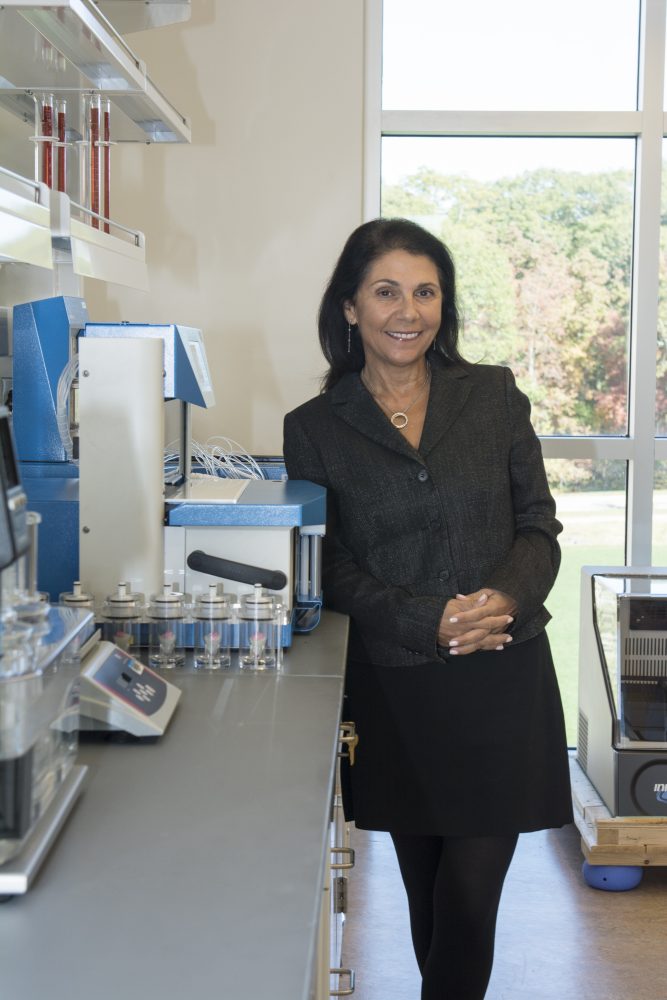Thanks to the largest gift in the University of Rhode Island’s history, courtesy of Tom and Cathy Ryan, the George and Anne Ryan Institute for Neuroscience has the ability to pioneer in the research on neurodegenerative diseases. In fact, they are truly making a name for themselves in the neuroscience world.
A wide misconception about the Ryan Institute is that it is a part of the Interdisciplinary Neuroscience Program (INP) at URI. In fact, the Ryan Institute is not affiliated with any college on campus and the director reports directly to the Provost office.
Paula Grammas, executive director of the Ryan Institute, explains that unlike the INP, “We do not grant degrees, we are not a degree-granting organization… [but] we are all under the overall [umbrella] of neuroscience.”
Because of a common interest, some professors in INP also conduct research within the Ryan Institute, and some graduate students within the INP also assist with research in the Ryan Institute.
“The ultimate goal is to develop disease modifying therapies for neurodegenerative disease,” Grammas said.
According the George and Anne Ryan Institute, they “support innovative research and collaborative partnerships that contribute to the development of therapies for neurodegenerative diseases. [They] are committed to integrating discovery science, translational medicine, education and community engagement to develop and deliver tomorrow’s treatments today.”
Tristan Davies, the assistant director for administration and communications at the Ryan Institute, explains that neurodegenerative diseases are diseases where the brain cells die. This includes Alzheimer’s, Parkinson’s disease, amyotrophic lateral sclerosis (ALS), cerebral palsy and others.
“The big question with all those diseases, is why do the brain cells die and what can you do to stop that from happening,” Davies said.
The faculty involved with the Ryan Institute come from a wide range of disciplines related to neuroscience in some way. This includes cell biologists, pharmacists, kinesiologists and other fields, “all of whom are doing work that one way or another intersects with a better understanding of the brain.”
A criticism for university science for many years has been what is called a “silo mentality,” the common belief was that sciences at universities did not work together and showed a reluctance to integrate their efforts into a common project. “One of the great changes in science over the past couple of decades has been greater collaboration among scientists and greater attention to things that are cross-disciplinary, multi-disciplinary,” Davies said. “So that’s been one of the key elements to how we’re trying to build the institute.”
“Science is very much a team effort,” Grammas said .
This year the Ryan Institute are introducing three new faculty members to join the team of researchers, William Van Nostrand from Stony Brook University, Katharina Quinlan from Northwestern University School of Medicine and John Robinson from Stony Brook University. Together, these three faculty members have brought in or will bring in about $7 million in federal funding.
Two of the new faculty, William Van Nostrand and John Robinson, have previously experience collaborating on research.
Because the Ryan Institute is not affiliated with any specific college, it is easier in some ways to partner with multiple organizations and people on and off campus. Van Nostrand’s specialty is on molecular biology, specifically the amyloid deposition and pathology in Alzheimer’s disease and cerebral amyloid angiopathy, while Robinson has his focus on behavioral and cognitive neuroscience. Working together, “the work that Bill does [on the molecular side] is then complemented by the behavioral work that John does,” Davies said. “They kind of play off of each other and make a fuller picture.”
Grammas is a pioneer in her research on Alzheimer’s. While most Alzheimer research has focused on two proteins that are found in brains of those with the disease, Grammas is taking a different root and focusing research on the role that brain blood vessels have in the development and progress of Alzheimer’s. Her and her research team’s hypothesis is “brain blood vessels are dysfunctional in Alzheimer’s disease and release toxic factors that kill nerve cells.”
“If we can intervene in that process we can stop that pathology from occurring and could potentially prevent this continual destruction of brain nerve cells,” said Grammas.
Now she and her team are moving forward into researching a therapeutic perspective to try to find a drug that would interfere with this process.
“I would say our research goes on two tracks,” Grammas said. “One is to work on a drug that we think may that we have data that suggests might be useful as well as to discover new pathways where we can interrupt again this pathologic process.”
The Ryan Institute is putting their efforts beyond this classical idea of science and discovery. “we’re spending a lot of our time on here is the idea of decisions you can make with your lifestyle that will affect your likelihood of developing dementia, or some other neurodegenerative based condition,” said Davies. The Ryan Institute has also pulled together a group of faculty from multiple departments across campus to discuss and promote the different things that can affect your chance of developing neurodegenerative diseases, or modifiable risk factors. These factors include diet, exercise, blood pressure and diabetes.
“A sort of good rule of thumb is if it’s good for your heart it’s good for your brain,” Davies said.
This past March, this group of faculty put together a family-friendly event called the URI Brain Fair, part of Brain Week Rhode Island, to educate people on how to keep their brain healthy and to learn more about this exciting field of research through creative, hands-on activities.





